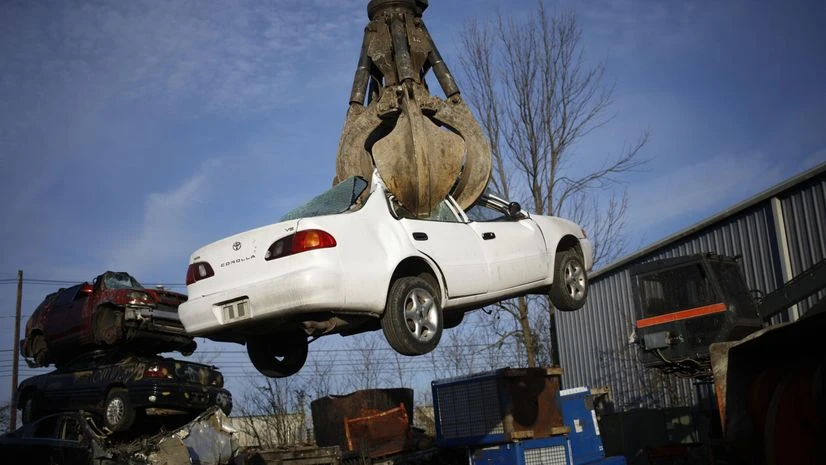By David Fickling
What sort of product do electric vehicle batteries most resemble — plastic bags or traditional car batteries? The answer is surprisingly fraught.
What sort of product do electric vehicle batteries most resemble — plastic bags or traditional car batteries? The answer is surprisingly fraught.
That’s because the vast expansion of electrified transport currently under way is going to generate a growing mountain of waste a decade hence. Decisions taken now will be crucial to whether that mass of lithium, graphite and base metals turns into an environmental crisis, or a model of efficient recycling.
Some 10.5 million EVs were sold last year, a number that will rise to 27 million in 2026 and more than 70 million in 2040, according to BloombergNEF. With the battery on a Tesla Inc. Model 3 weighing it at just under half a metric ton, that means the world will be seeing tens of millions of tons of cells being junked every year from the mid-2030s.
If EV batteries are like plastic bags, that’s a disaster. Only about 10% of plastic packaging gets recycled in the US, with about 3 million tons each year going into landfill. Treat spent cells that way and you’re looking at vast volumes of heavy metals being buried, risking fires in waste facilities and the release of toxic metals into soil and groundwater.
Alternatively, we could treat them like old-school car batteries. There’s hardly any product on the planet that’s recycled at higher rates than the 99% levels managed by lead-acid cells. Repeating that achievement with lithium-ion might make a surprisingly small dent in the 76 million tons of nickel, lithium and cobalt that BloombergNEF reckons we’ll need by 2050. (Until EV sales’ meteoric growth starts levelling off around the middle of this century, the metal demand from new cars will vastly outstrip the supply from recycling 10-year-old clunkers.) Even so, it would help make electric vehicles eventually become a sustainable part of the circular economy.
Also Read
The lessons from lead-acid recycling aren’t particularly comforting, though. Traditional batteries all follow a uniform design that hasn’t changed much since the 19th century. After the cells are pulverized, the main materials — lead, acid, and plastic — are easily separated in flotation tanks, before the metal is passed through a smelter to produce relatively pure lead bullion.
Electric vehicle batteries, on the other hand, cover an ever-changing gamut of established and emerging chemistries and mechanical designs. Car manufacturers traditionally focused their expertise on engine design and outsourced most of the rest of the car to parts suppliers. With engines going the way of the dodo, they’re now keen to differentiate themselves based on their different electric power technologies.
Even setting chemistry aside, the simple positioning of screws and welds could confound efforts to carry out efficient large-scale reuse. It costs about four times as much to dismantle a Nissan Leaf battery as one from a BYD Han, according to one study published in February.
That’s a problem. Recycling is a low-margin business that performs best when (as with lead-acid batteries) the waste streams are relatively pure and uniform. The same goes for utilities, who could use batteries too degraded for vehicles to help balance out fluctuations in power supply from wind and solar generators, but need a good understanding of what they’re connecting up to make it worth the effort.
The profitability of battery recycling depends largely on the value of their most important constituents, such as cobalt and lithium — but with prices of those raw materials falling by about 60% and 35% respectively in the past year alone, it’s anyone’s guess what those numbers will be when the current wave of cells comes on the reuse and recycling market a decade hence.
Where such recovery is too difficult, even valuable raw materials aren’t sufficient to overcome the advantages of buying a new product off the shelf. Little more than half of all car catalytic converters are recycled, despite their rich payload of platinum-group metals. The recycling industry is already facing a glut of capacity, as my colleague Adam Minter has written. The last thing we need is a wave of bankruptcies killing off the nascent sector for good.
Governments can play a role in fixing this. Manufacturers will resist making identical battery packs, but a nudge in the right direction could foster sufficient standardization to keep the reuse and recycling industry in the black. Simply labelling battery components with uniform QR codes would make it easier to sort waste cells into usable streams. Better still, governments could establish a credits system similar to those the EU uses for carbon emissions and the UK for product packaging, making manufacturers pay for battery disposal unless they can transfer the risk to recyclers or investors via tradable securities. Tough landfill taxes would help, too — and standards will need to be global, since many vehicles in rich countries end up sold second-hand in emerging economies.
Tens of millions of tons of EV battery waste may seem small next to the 2.5 billion tons of gasoline and crude oil that we burn each year and the 610 million tons of scrap steel (much of it from junked vehicles) we produce. Still, if we want a sustainable economy fit for the 21st century, governments and the EV industry need to tackle this problem now. It’s only going to get bigger.
Disclaimer: This is a Bloomberg Opinion piece, and these are the personal opinions of the writer. They do not reflect the views of www.business-standard.com or the Business Standard newspaper
Disclaimer: This is a Bloomberg Opinion piece, and these are the personal opinions of the writer. They do not reflect the views of www.business-standard.com or the Business Standard newspaper

)
